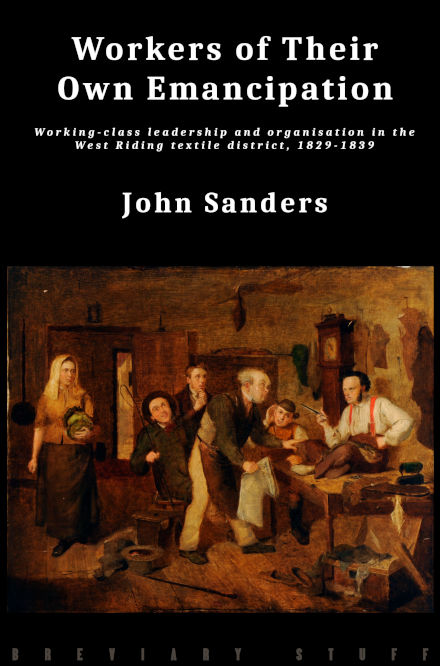- Abbreviations
- About the Author
- Acknowledgements
- Introduction
- 1 Local Leadership and Organisation
- 1: Local Leadership – An Introduction
- 2: Identifying Local Leaders
- 3: Levels of Leadership
- 4: Types of Leader
- 5: The Making of Local Leaders
- 6: The Attractions of Leadership
- 7: The Drawbacks of Leadership
- 8: Analysis of Leadership
- a) Gender
- b) Age
- c) Origins
- d) Ethnicity
- e) Religion
- f) Occupation
- g) Other Lives
- 9: Local Organisations
- 2 The West Riding Textile District: Industry, Trades and Trades’ Unionism
- 1: The West Riding Textile District
- a) Leeds
- b) Bradford
- c) Halifax
- d) Huddersfield
- e) Keighley
- f) Dewsbury
- g) Industrial villages and out-townships
- 2: Industry, Trades and Workers
- a) ‘Upper’ Skilled Craftworkers
- b) ‘Lower’ Skilled Artisans
- c) Textile Outworkers
- 3: Trades’ Unionism, 1831-4
- 3 Popular Radicalism and Reform, 1829-32
- 1: Political and Economic Background
- 2: The First Stirrings, 1829
- a) Almondbury Operatives
- b) Leeds Radical Reformers
- 3: Radical Reformers and Political Unions in Early 1830
- a) Radicals and ‘renegades’ in Leeds, January-September 1830
- b) The Birth of the Almondbury Political Union
- 4: New Political Unions in Later 1830
- a) Political Unions and the Yorkshire Election, March-August 1830
- b) Aftermath of the July Revolution, August-December 1830
- 5: Reactions to the Reform Bill, March-June 1831
- 6: The Crisis of October 1831
- 7: The ‘May Days’, 1832
- 8: The First Reformed Elections, June-December 1832
- 4 Early Co-operation, 1829-34 and Beyond
- 1: Introduction
- 2: Leeds, Bradford and the Villages
- 3: Halifax
- 4: Huddersfield: Early Development and Links with Liverpool
- 5: Hirst, ‘Community’ and Owenism
- 6: The Huddersfield Congress, and Commercial Orders, 1833-4
- 7: Owen and the ‘Grand National Moral Union’
- 8: Postscript: Huddersfield, 1834 and Beyond
- 9: Conclusion
- 5 The Early Factory Movement, 1830-4
- 1: Introduction
- 2: The Early Short Time Committees
- 3: Ten Hours, Radicals and ‘Tory-Radicals’
- 4: Ten Hours, Trades’ Unions and Factory Workers
- 5: Fusion, Disillusionment and Regeneration, 1833-4
- 6 Radicalism and Popular Movements, 1833-7
- Part One
- 1: Political Unions and Popular Agitations, 1833-4
- 2: Local and National Politics in the Mid-1830s
- 3: Radical Culture in the Mid-1830s
- 4: Joshua Hobson, the Voice and the Struggle for a Free Press, 1833-4
- 5: The War of the Unstamped, 1834-6
- Part Two
- 6: Radical Organisations, 1835-7
- 7: Dorchester, Glasgow and the Handloom Weavers’ Campaigns, 1835-8
- 8: Factory Reform and Anti-Poor Law Agitations, 1835-8
- 7 Early Chartism
- Overview
- 1: The Emergence of Chartism
- 2: Local Studies
- a) Leeds
- b) Bradford
- c) Huddersfield
- d) Halifax
- e) Keighley
- f) Dewsbury
- 3: Leadership and Support
- Introduction
- Leadership
- a) Levels
- b) Occupational analysis
- c) Local variation and change
- Support
- a) Factory and non-factory
- b) Chartism and Trade Unions
- c) Chartism and Friendly Societies
- 4: Regional and National Perspectives
- 5: Early Chartist Themes
- a) Physical Force, the Rhetoric of Resistance and Chartist Arming
- b) Intimidation, Restraint and Reaction
- c) Conspiracy and Insurrection
- d) Culture, Class and Conflict
- Epilogue
- Bibliography
- Index
John Sanders – Workers of Their Own Emancipation
Original price was: £25.00.£20.00Current price is: £20.00.
This book traces the complex pattern of working-class radical endeavour in the West Riding textile district during the years from 1829 to 1839. It focuses in particular on questions of local leadership and organisation and stresses the importance of these elements to early working-class movements. The study assesses the significance of the trade union, popular radical, early co-operative and factory reform agitations of the late 1820s and early 1830s in shaping leadership cadres and organisational structures. It goes on to map out the varied, often mutually reinforcing campaigns of the mid 1830s which came together in the early Chartist movement. Chartism, with its more confident, experienced and self-reliant local leadership and its stress on organisation, is shown to be the culmination of a decade of escalating conflict and prodigious activity. It drew on the radicalising experiences of the early 1830s, on the incremental growth of working-class disillusionment in the post-Reform era, and on the common experiences and uncertainties which large sections of the local working population shared. Whilst building on traditional ideas and agitational tactics, the early Chartists increasingly articulated an assertive, class-conscious alternative to the widely-perceived evils of unregulated competitive industry and unrepresentative, uncaring government. Far from being peripheral figures, the local leaders who emerged in this era were central to the story of the emergence of the world’s first mass working-class movement. For this reason, the efforts of contemporaries to perpetuate their memory deserve to be continued, so that a few more at least, do not share the fate of the many who ‘died unknown’.




